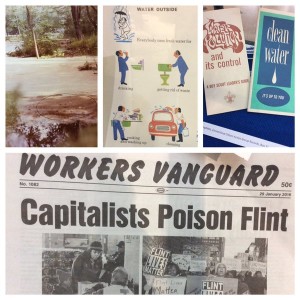 On display now in the McDonald Reading Room, and through February, a new exhibition by Archivist Graham Stinnett examines the role that water plays in our daily lives. From consumption and utility to containment and disposal, clean water relies heavily on human impact on the ecosystem. As archival documents reveal, water protection and access to clean drinking water has been a rallying cry for decades, long before it made national headlines, again, last month.
On display now in the McDonald Reading Room, and through February, a new exhibition by Archivist Graham Stinnett examines the role that water plays in our daily lives. From consumption and utility to containment and disposal, clean water relies heavily on human impact on the ecosystem. As archival documents reveal, water protection and access to clean drinking water has been a rallying cry for decades, long before it made national headlines, again, last month.
Since the breaking news of the Flint Water Crisis began, a state of emergency within the city of Flint, Michigan was called on January 5, 2016. The city had incorporated its drinking water from the nearby contaminated Flint River which led to the corrosion of aging lead pipes in the city’s waterworks. This leaching of lead began in April of 2014, exposing the population to health risks associated with drinking and bathing in the water unbeknownst to them.
This exhibition draws from collections in Archives and Special Collections, including the Connecticut Citizens Action Group Records and the Alternative Press Collection, relating to water and our demands upon it as a resource and a necessity. The materials document that water protection is not a new social issue in the US. Since the 1960s, as the historical record illustrates, failing economies, and lack of investments in cleanup in the long term, have lead to crises for already marginalized communities. Materials in the exhibition, encompassing photographs, leaflets, serials, clippings, and government documents, examine how people in those communities have responded through time.
